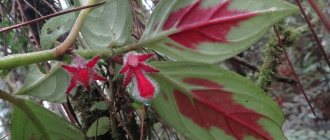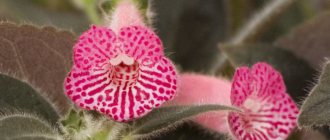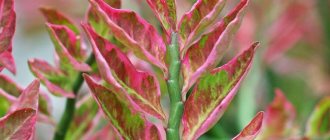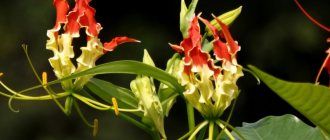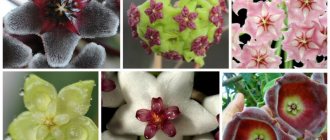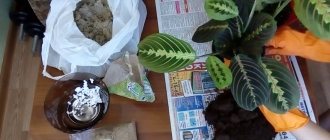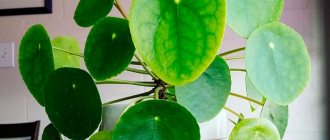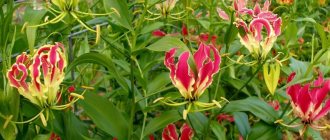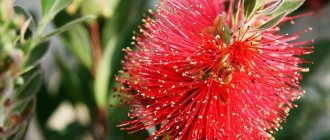- home
- Plant catalog
- Ampelous
Reading time: 10 minutes
11481
Nematanthus is a unique plant native to South America. The crop belongs to the Gesneriaceae family, which grows in the wild. There is a wide variety of species, which range from epiphytic lianas to shrubs.
Nemanthus and hypocyrta were previously considered different plants, but now they are classified as the same species. The name Nemanthus was given by the German scientist Heinrich Adolf von Schröder, combining two Greek words: nema - “thread” and tantus - “flower”.
And the name Hypocyrta was given by the famous botanist Martius. It also consists of two Greek words, which in translation mean “under” and “curved.” This is how you can describe the appearance of this flower, which grows by bending its shoots downwards.
In this article we will look at the main types of hypocyrta, proper care at home, and photos of the plant.
- External characteristics
- The main varieties of Hypocyrta glabra
- Nematanthus nummularia
- Nematanthus gregarius
- Nematanthus fluminensis
- Nematanthus fritchii
- Nematanthus longipes
- Nematanthus wettsteinii
- Watering
Botanical description
Nematanthus is a tropical plant. Latin America is considered to be its homeland.
The flower is a small shrub with small, waxy, dense leaves located on curly elastic shoots. It blooms in summer with medium-sized bright single flowers, thanks to which it received another name - “kiss of summer”.
| Root system | Branched, superficial, thin roots |
| Stem | Dense, fleshy, creeping |
| Leaf color | Dark green, waxy, glossy |
| Flower shape | Tubular, expanding at the bottom |
| Flower color | Depending on the variety, the shade varies from yellow to red. |
| Fruit shape | Seed pod |
Fritchii
Nematanthus Fritsch is one of the largest and rarest representatives of Nematanthus. A tall plant, sometimes reaching 70 cm. The shoots are thin, drooping down as they grow. The leaves are long, with a reddish tint below, and have fluff on the underside. The flowers are bright, pink, funnel-shaped. In the photo you can see what the flower looks like.
Main types
Hypocyrta comes in many different species.
Some of them are ideal for growing at home:
- Hypocyrta Monetnaya - This is an unusual species with creeping stems. A distinctive feature of this variety is the fluff covering the rounded leaves of the plant. The length of the shoots does not exceed 15 cm, the flowers are glossy, orange-red. For the winter, this variety sheds its leaves;
- Glabra - is a small shrub with erect, dense stems covered with glossy small elongated leaves - dark green on top and lighter below. The height of the shoots is approximately 50–60 cm, at the base of the leaves there are orange buds in groups of 2–3 pieces;
- Tropicana - a magnificent view with diamond-shaped glossy leaves of a dark green color. The stems are tall and straight. The variety blooms profusely and continues throughout the summer. The flowers are yellow, with dark orange stripes along the bud;
- Gregarius - is a hanging plant with low-creeping stems. The leaves are small, shiny, densely located on the shoot; have an elongated, slightly pointed shape. The culture blooms with small tubular flowers (depending on the variety - red or yellow);
- Nematanthus Columnea - the most striking representative of this species. The stems are semi-erect, approximately 30–40 cm long, the foliage is large, green, pointed, with deep veins. The flowers are large, tubular, scarlet in color. This variety is separated into a separate genus due to a number of external differences from the classic representatives of Nematanthus;
- Variegated - got its name due to the unusual color of the foliage: small, waxy leaves in the center are dark green, and have a light green edge along the edges. Sometimes there is another option - light leaves with dark “scorches” along the edges. The flowers are standard orange.
General information
According to the reference book “All about Houseplants” by Dr. D. G. Hession, an English botanist: “Hypocyrta glabra (Hypocyrta glabra) prefers high humidity. The stems are erect or gracefully drooping, and orange, waxy flowers appear in summer. Hypocyrta nummularia (Hypocyrta monetata) is a hanging plant.”
Numerous flowers of Nematanthus (Hypocyrtus) look like small goldfish. This is a beautiful bushy plant with shiny dark green succulent leaves. The lower part of the leaf is painted burgundy, which gives the indoor plant additional charm.
Nematanthus is a liana. Nematanthus species with pubescent foliage curl less, so they are used in arrangements as cascading specimens.
Conditions for growing at home
Hypocyrta is a very popular plant for home cultivation. All the varieties described above take root safely in conditions that are comfortable for them.
At home, decorative foliage plants such as zebrin flower, cordyline, aphelandra, diplandia, and monstera are also grown.
Lighting
This flower crop is a light-loving plant (with sufficient lighting it is guaranteed to bloom for a long time). But the plant does not tolerate direct sunlight well, and in the summer heat this can lead to leaf burns. Intense but diffused light is recommended for the flower; In winter, you can use a source of artificial lighting.
Temperature
Despite the fact that hypocyrta is native to countries with hot climates, heat is contraindicated for this home plant. The ideal microclimate for the “kiss of summer” involves maintaining an optimal air temperature of +22...+24°C in summer and +14...+16°C in winter.
Important! Nematanthus is especially sensitive to drafts and sudden changes in temperature.
Air humidity
A tropical flower feels very comfortable in conditions of high humidity (if it is above 80%). That is why it is recommended to spray it frequently, and also place containers of water around the pot with the plant.
How does Nemantanthus reproduce?
It is advisable to carry out the plant propagation procedure in the warm season: spring or summer.
Unlike many flowers, nemantanthus propagates only using apical cuttings.
For this purpose, shoot tips that do not have flowers and have 5 nodes are selected. It is not recommended to take young stems due to the fact that they are most susceptible to rotting. The two lower leaves are torn off, and the remaining part must be rooted in a moist mixture consisting of peat and sand, or the cutting is placed in a vessel with water.
The container with the planted cuttings is covered with plastic wrap or a glass jar and placed in a warm place, protected from drafts, in which there is a sufficient amount of diffused light. The ideal temperature is 20-25 degrees Celsius.
In order for the cuttings to take root well, they must be sprayed and ventilated daily.
Rooted cuttings are planted several at a time into permanent pots. From a decorative point of view, it will look more interesting than if they grow alone.
Home care
Nematanthus is not too demanding to care for, but the basic rules must be followed.
Watering
Hypocyrta should be watered abundantly and regularly in the summer. Lack of moisture is detrimental to the flower; The water should be at room temperature or slightly warmer.
In autumn and winter, the frequency of watering is reduced. During this period, water the plant as the top layer of soil dries. Because the root of the plant is delicate and sensitive; To avoid damage to it, watering is carried out exclusively at the root, from a small height, drip (using a watering can, for example), and not with an intense stream.
Top dressing
It is necessary to fertilize the flower. Use ready-made industrial mineral fertilizers for flowering indoor plants “Promix” or “Fertika”. Complex mixtures with nitrogen and potassium fertilizers, which provide support during the growing season, would also be a suitable option. Fertilizing is carried out from April to September at least once every 7–10 days, when growth and flowering are intense. Fertilizer is applied at the root, combining with the next watering.
Read more about what and how to feed indoor plants.
Trimming
To ensure good branching and flowering in the next season, nematanthus shoots are pruned before the onset of winter cold - during the period when the plant slows down its life processes. Typically, each stem is cut to about 1/3 of its length.
Transfer
Good news for flower growers may be the fact that hypocyrta does not require traditional annual replanting. Its root system is quite thin and develops with moderate intensity, so transferring it to a new pot can be done once every 2 years. The pot for the flower is chosen to be small, in proportion to the branching of the roots (it is desirable that it be short and wide).
The soil should be light and porous. From ready-made substrates, a soil mixture for homemade violets is suitable, and when preparing the mixture yourself, it is enough to mix peat, sand, humus and leaf soil in equal proportions.
The plant is replanted in the spring before the flowering period begins: from early March to early April. You need to transfer the flower into new soil together with the earthen lump surrounding the roots to prevent them from being damaged. A layer of substrate is poured onto the bottom of the new pot, a small depression is made in it, into which the root is placed; then add the required amount of soil mixture so that it fills the voids of the container.
Important! It is imperative to create voids and a drainage layer in the container with the plant, otherwise root rot may develop.
After transplanting, the flower is watered with warm water, and after a few days, ready-made nitrogen-potassium fertilizers for indoor plants can be applied to the root.
Propagation by cuttings
Hypocyrta successfully reproduces by cuttings. You can separate cuttings for propagation during a period of intensive plant growth, when the length of the shoot is sufficient (at least 6–7 nodes with buds). The cut shoot is placed in a container with wet sand, deepening to the lower leaves.
Caring for a seedling does not differ in technology from caring for an adult plant (with the only exception that it is recommended to cover it with a cap). From time to time, the sprout needs to be ventilated and hardened in room conditions. The air temperature should be within +22…+24°C.
As soon as the cutting gives its first long roots, it can be transplanted to a permanent habitat. It is allowed to plant one or several shoots in one pot.
We recommend reading how to properly plant indoor flowers in a pot.
Interesting video
We invite you to watch a video about proper care of Hypocyrta naked:
Sources
- https://tsvetem.ru/tsveti_v_dome/gipocirta.html
- https://WhatFlower.ru/houseplants/gipocirta-foto-uxod-v-domashnix-usloviyax-i-pri-posadke-v-otkrytyj-grunt-bolezni-i-vrediteli-nematantusa-i-kak-uxazhivat-za- cvetkom-zimoj/
- https://procvety.net/katalog-rastenij/ampelnye/nemantus-ili-gipocirta-7-vidov-s-foto
- https://RoomFlower.ru/komnatnye-tsvety/ampelnye/nematantus.html
- https://MrDachnik.com/gipocirca
- https://floristics.info/ru/stati/2712-nematantus-v-domashnikh-usloviyakh-gipotsirta.html
- https://selo.guru/rastenievodstvo/derorativ/nematantus/gipocirta-golaya.html
- https://greensotka.ru/dekorativno-listvennye/gipotsirta-glabra.html
- https://pocvetam.ru/komnatnye-rasteniya/dekorativno-listvennye/gipotsirta-glabra.html
- https://dacha.help/cvety/nematantus-uhod-v-domashnih-usloviyah-foto
Possible difficulties during cultivation
Despite the ease of care, novice gardeners may encounter some problems when breeding hypocyrta:
- if you water a plant with too cold water , its immunity will begin to weaken; This may cause dark or reddish spots to appear on the leaves. A similar phenomenon is observed when there is no watering for a long time. To avoid this problem, water the flower with settled soft water at room temperature, and in winter - slightly warm;
- lack of flowering is one of the main problems. There can be many reasons, but most often it is a lack of light, lack of feeding and sudden changes in room temperature. If such a difficulty arises, you should act in stages: first of all, you need to eliminate drafts. If the plant still does not bloom, it is necessary to move it to a more illuminated place away from direct sunlight;
- the plant loses foliage when there is excess moisture , fluid retention in the root area, and also when kept in a cold room. If you notice the loss of foliage, you should limit watering, move the flower to a warm place and wait until the earthen ball dries out. After the measures have been taken, watering is organized in such a way that the liquid does not linger at the bottom of the pot (drainage is used). In some cases, when signs of rotting appear, the plant is replanted, removing rotten roots during replanting;
- Violation of the humidity level and excessive watering can cause the appearance of powdery mildew or gray rot. If signs of these diseases are detected, you need to treat the leaves and stems with an industrially produced fungicidal solution - for indoor plants. The most commonly used preparations are Bona Forte or Discor (or a pale pink solution of potassium permanganate). The affected shoots are removed and the plant is moved away from healthy flowers.
To prevent the occurrence of the described problems, it is enough to strictly adhere to the rules of caring for the flower and prevent it from hypothermia.
Pests
Hypocyrta is rarely attacked by pests. Most often, with improper care, the flower weakens and becomes depleted, becoming vulnerable to various kinds of parasites.
Aphid
These small insects are difficult to immediately notice on the plant. Aphids suck juices from parts of the plant, causing the young shoots and buds affected by the pest to curl and wither.
To cope with insects, it is necessary to treat the plant with specialized aphids ; these preparations contain a substance - permethrin.
For prevention, the plant is provided with the necessary care: regular pruning, organizing proper watering and air humidity.
Mite
The spider mite is a small insect that also feeds on plant juices . They live on the underside of leaves, and the pest can be detected by light spots on the foliage and barely noticeable cobwebs.
Insecticides do an excellent job of controlling them. If there are only a few insects, you can remove them using a cotton pad moistened with soapy water.
Mealybug
These parasites hide in the axils of leaves . If white cotton-like lumps are found, they are removed manually using a cotton pad soaked in alcohol.
And after carrying out the procedure with areas, the entire plant is treated.
Thrips
The most common plant pests. Thrips are very small black flying insects . When they come together, they form gray streaks on the leaves that look like dust. They feed on the juices of the plant, causing it to slow down its growth and the flowers to become deformed.
At the first signs, it is necessary to treat the plant with an insecticide to prevent further reproduction of insects and the damage they cause to the plant.
Hypocyrtha is a plant with incredibly bright, glossy green foliage and beautiful yellow or orange goldfish-like flowers. With proper care, it can delight you with flowering for up to 4 months a year.
Growing nematanthus in our homes is still exotic. Read our articles about other popular species of this flower - Gregarius radicans and Hypocyrta glabra.
The basic principles of caring for this exotic plant: organizing regular sufficient watering, bright indirect lighting, air humidity and fertilization. also needs pruning and a period of rest in a cool place so that the hypocyrta can recover and gain strength for future flowering.
Folk signs and superstitions
Like most indoor plants, nematanthus acquires a lot of beliefs and mysterious signs, namely:
- this flower is capable of attracting wealth to the house; its owner is guaranteed financial well-being and professional growth;
- hypocyrta is a healing flower: if a person is sick, the stems of the plant will certainly droop.
Did you know? Many flower growers have confirmed another theory in practice: if you place a pot of nematanthus next to a sick plant, the sick flower will soon recover from its illness. It is believed that hypocyrta actively releases phytoncides into the atmosphere. This is the name for substances that inhibit the growth and development of pathogenic bacteria.
So, acquaintance with an unusual flower plant called “hypocyrta” makes it possible to draw conclusions about its unpretentiousness. Flower care is simple and accessible even for beginner indoor flora lovers. Following simple rules will allow you to easily grow a magnificent, long-flowering crop that will decorate any room.
